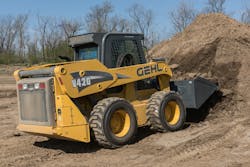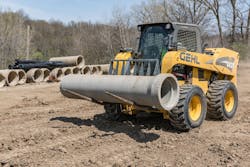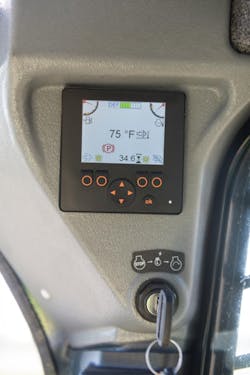Skid Steer Has Wheel-Loader DNA
To say that the new Gehl V420 has impressive specifications for a skid steer loader is a bit of an understatement. Operating weight is nearly 11,700 pounds; rated operating capacity is 4,200 pounds; its Tier 4-F Deutz engine produces 121 gross horsepower; a standard high-flow auxiliary-hydraulic system delivers nearly 41 gpm at pressures to 3,450 psi; and the vertical-lift loader linkage provides 12 feet of clearance under the hinge of a standard 1-cubic-yard, 84-inch bucket.
“The V420 is designed for equipment users considering a compact wheel loader, but don’t have the space on typical jobs to accommodate a machine of that size,” says Brian Rabe, regional training manager, Manitou North America. “Compared with most compact wheel loaders with similar operating weights and bucket capacities, the V420’s dimensions are significantly more compact, and it has considerably more horsepower and more auxiliary-hydraulic capacity. On the high-end of skid steer loaders, a few competitive models come close to the V420’s specifications in one category or another, but none offer the V420’s overall combination of specs.”
Production versions of the Gehl V420 began coming off the assembly line at Manitou North America’s Compact Equipment Division facility in Madison, S.D., just a couple of months ago, and these units were quickly placed in dealer inventories. The company, however, was gracious enough to accommodate Construction Equipment’s request for a unit to evaluate by delivering the most recent pre-production model to I.U.O.E. Local 649’s training center in Bartonville, Ill.
In standard trim, the V420 is generously equipped—with an enclosed, sealed/pressurized cab; HVAC system; pilot-operated joystick controllers; air-suspension seat; Bluetooth radio; electronic hand and foot throttles; Power-A-Tach hydraulic coupler; high-flow auxiliary hydraulics (with 14-pin electrical connector); self-leveling linkage; two-speed travel system; and the company’s Hydraglide ride-control system.
Tires on the test machine were 14-17.5 Titan 2000 II (other sizes and styles are optional), and attachments that arrived with the unit included the standard 27-cubic-foot bucket, a set of forks, and an 84-inch Edge Attachments hopper broom.
Local 649’s Brad Walker, an operator/instructor for the Local’s Apprenticeship and Skill Improvement Program (ASIP), and Bobby Kisner, a first-year ASIP apprentice, spent most of a warm, early-May day with the V420—stockpiling, loading trucks, excavating, lifting, and making load-and-carry runs. As the operators alternated using the machine in these various exercises, CE solicited their comments when they exited the cab.
Overall performance
Initial impressions centered on the V420’s power and stability.
Gehl V420 Specifications
Rated operating capacity: 4,200 pounds
Operating weight: 11,665 pounds
Engine: Deutz TD 3.6
Power: 120.7 horsepower
Torque: 354 lb.-ft.
Height to bucket hinge: 144 inches
Tilt breakout force: 9,040 pounds
“I liked the weight and power of the machine,” said Walker. “I liked the torque it has for pushing into the hard material that we have here. On some machines, if you forced the bucket into the pile as hard as we were doing here, there’d not be enough power left to run the hydraulics at a reasonable speed. I tried to stall it, but it has enough power to handle both tractive effort and maintain a good lift speed in difficult digging. The machine has enough weight to keep a lot of torque to the wheels—there wasn’t much wheel spin even in hard digging.”
But experience counts. Kisner, benefiting from the tutelage of the expert operator/instructors at Local 649, is already a good operator, but admits he’s still learning the finer points of running various machines.
“This machine really does have so much power, that you have to work with it for a while and make some adjustments to control wheel spin,” he said. “But since it has both a hand throttle and a foot throttle, it’s easy enough after a while to manage the power to wheels.”
The V420’s 3.6-liter Deutz engine, Rabe told us, replaces the 99-horsepower engine used in the new machine’s predecessor, the V400, and in addition to developing about 22 more horsepower, the Deutz also develops more peak torque, 354 lb.-ft. at 1,600 rpm, versus the V400’s 326 lb.-ft.
“At 354 lb.-ft., the V420 has substantially more torque than its competitors,” said Rabe, “and coupled with that is the engine’s basically flat torque curve. Peak torque is at 1,600 rpm, but it develops about 300 lb.-ft. at 500 rpm and around 340 lb.-ft. at high idle. So torque is fairly constant through the rpm range, which allows the operator to throttle back in many applications and still have an aggressive machine.”
As noted, the V420’s overall stability was also high on the list of the operators’ first impressions.
“I like the fact that the weight of the machine keeps it on the ground—it’s not bouncing around on the tires,” said Walker. “It’s a very stable machine. In fact, I ran it with the bucket in the air just to see how it would react, and it remained flat-footed. I also backed it up about 3-to-1 slope with pipe on the forks, and it seemed very stable on the incline.”
“When we were loading trucks, the area around the truck was fairly uneven, but the machine was still stable even with the bucket in the air,” he said. “Never felt as if the back wheels were going to come off the ground. The bucket on this machine seems longer than on most skid steers and it fills easily. The hydraulics handle it well—there was never any sort of a lag. It has excellent breakout—good hydraulic power.
“One thing I did notice, though, is that when you’re backing off an incline, it doesn’t take much to get hung up momentarily.”
In response, Rabe said that at 19 degrees, the V420’s angle of departure is somewhat less than its competitors, but that the overall design of the V420—or any machine, for that matter—requires certain engineering concessions when developing a package for optimum performance. But it’s an element that will be addressed as the design evolves, he said, and suggested that if the angle of departure was a concern in a particular operation, then a larger tire would help.
The V420’s stability noted by both operators likely is the result of its relatively long wheelbase (54.6 inches) and an operating weight that exceeds that of some compact wheel loaders. Operating weight, in fact, is about 800 pounds greater than that of the V400, resulting in part, said Rabe, from adding Tier 4 aftertreatment systems, a diesel oxidation catalyst and a selective catalytic reduction
system with its attendant tank for diesel exhaust fluid.
To make space for the aftertreatment systems, the fuel tank and hydraulic tank were moved from their positions on the V400 (in the forward part of the engine compartment) to the rear bumper on the V420. The tanks, said Rabe, are fabricated of heavy-duty steel and well-protected. Relocation of the tanks to the rear of the machine, he said, accounts in part for the V420’s 200-pound increase in operating capacity, compared with the V400, and improves machine stability and balance.
In another performance test, the operators installed the V420’s forks and moved concrete pipe. Both agreed that the machine handled the task well. To push the machine a bit harder in this exercise, Walker lifted and carried a large stone box in the test area.
“I’m sure we were over the machine’s rated capacity with the box—it probably weighs around 5,500 pounds,” he said, “but the machine handled it with no problem.”
Operator’s environment
The V420’s operator’s station incorporates a Level II falling-objects protective structure and features a new side-folding restraint bar, new LCD display that can be customized to user preferences, and new upper-left and upper-right instrument panels. Walker and Kisner agreed that the cab interior provided ample leg and elbow room and that controls were easy enough to use. But that said, they did have a few items on their wish lists.
“I missed having a mirror or backup camera,” said Walker. “A mirror would be fine with me—just something that lets you glance back at the path you’ve just cut to make sure no one has slipped in behind you.”
Rabe told us that a backup-camera package is available for the V420, and that the machine is camera-ready. Likewise, he said, mirror packages also are available, and most production machines likely will be so outfitted. The unit on site, he reminded us, was a pre-production model that wouldn’t necessarily have optional equipment.
Overall visibility, however, was judged exceptional by both operators.
“Visibility on this machine is excellent—all around,” said Walker, “probably the best I’ve seen in a skid steer. In particular, the big side screens and the design of the lift arms gives a really good view to the sides.”
The V420 features redesigned panels (top) and controls. Joystick switches (bottom), used in conjunction with the 14-pin connector, control attachment movement. Switches could be used to control a cold planer’s depth, tilt angle, and side shift; yellow button would control an optional water kit.
The Gehl PowerView boom has been redesigned for the V420, said Rabe, making it stiffer to handle the added operating capacity and changing the profile slightly to afford the enhanced visibility Walker noted.
“I noticed that visibility to bucket was better on this machine than on most skids,” said Kisner. “The loader linkage doesn’t have the cross beam used on some machines that restricts your view of the bucket when it’s raised.”
Kisner did ask, however, why the V420 doesn’t have a slide-up front window, which he prefers.
“It’s sometimes an advantage to operate without the glass in front of you,” he said. “When you’re grading, for instance, and the sun hits the glass at just the right angle, it can be a problem. A slide-up window is an easy solution.”
In regard to a slide-up front glass versus the V420’s swing-out door (with a dome-shaped, wide-view glass), Rabe said that the door can be easily removed if the operator prefers—but does require a simple procedure to disarm the “door-open” sensor. Gehl compact track loaders do have a vertical opening front glass, he said, and future skid steers might incorporate the design.
Both operators took note, however, that with the door closed and the AC running, the V420 has high in-cab sound levels.
Rabe told us that sound-attenuating measures are being considered, but the company is waiting until enough production machines have been tested in Europe against EU (European Union) sound standards. Once completed, he said, the necessary sound-suppression measures will be designed, and if necessary, supplied to customers in kit form.
For what it’s worth, much of the sound, at least from a bystander’s perception, seemed to emanate from the V420’s variable-speed hydraulic fan. Rabe acknowledged this, and told us that the company is investigating alternate fan designs, perhaps, he said, a design that encloses the tips of the fan blades to contain more sound in the engine compartment—possibly complemented by a sound-attenuating package for the compartment.
Sound issues aside, both operators gave exceptionally high marks to the V420’s overall operator friendliness—including such features as pilot actuation of the control levers, operator-selected self-leveling linkage, boom-float capability, and the Hydraglide ride-control system.
“Might seem like a small point,” said Walker, “but the pilot-controlled levers are among this machine’s best features. I’m of the opinion that pilot controls, compared with electro-hydraulic controls, provide excellent feedback—which I think most operators appreciate.”
Kisner agreed. “I think you can be much more precise with a pilot system, versus an electro-hydraulic system.”
And the self-leveling linkage, which is a hydraulic-type system that functions when the boom arms are raising?
“Anyone who’s ever run a skid steer has dumped material on the roof,” said Walker. “Self-leveling is a great feature, and this system works well.”
The operators used the V420’s boom-float feature when running the broom, and both agreed the system has merit.
“I experimented a bit with the float feature,” said Kisner, “and it worked well with the broom. I think it would be an advantage in light grading or maybe snow removal.”
Perhaps the feature that most impressed the operators, though, was Hydraglide.
“We’ve all bounced around in skid steers, so ride-control is a big deal for the operator,” said Walker. “When we were hauling pipe around, I was running across some pretty good bumps, hills, and dips, but it was still a comfortable ride. If you’re doing load-and-carry with dirt or gravel, you can run with a load and not have to be concerned about cleaning up after yourself, because the material stays in the bucket.”
“This ride-control system really works well,” said Kisner. “It’s a game changer.”




